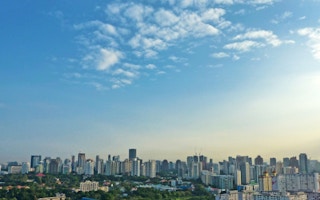Singapore’s Prime Minister Lee Hsien Loong recently explained in the country’s National Day Rally speech how the country will fight climate change, which he agreed was “one of the gravest challenges facing humankind”.
The Prime Minister acknowledged that the Southeast Asian country is already feeling the impact of global warming through hotter weather (Singapore is warming twice as fast as the rest of the world – at 0.25 degrees Celsius per decade – according to Meteorological Service Singapore), heavier rainstorms and rising sea levels and suggested that Singapore needed at least S$100 billion (US$72 billion) to build its defences against nature’s wrath.
The Prime Minister’s policy speech of the year starkly highlights the asymmetrical impacts of climate change: Rich countries and rich people can throw money at it, poor countries and the poor pay the price. But rich countries can and should and need to do much more, and Singapore is no exception.
“
The Prime Minister’s policy speech highlights the asymmetrical impacts of climate change: Rich countries and rich people can throw money at it, poor countries and the poor pay the price.
Here are measures the city-state should embrace, as a matter of urgency, if it is to contribute to the fight against climate change rather than simply be on the front-lines of suffering from its impact.
Air-conditioning and plastic
First, the low-hanging fruit: Air-conditioning and plastic.
Did you recently suffer freezing temperatures at the office in Singapore? I’ve been to so many offices where people are wearing sweaters because the temperature is maintained at a level 40 per cent cooler than it needs to be.
With the stroke of a pen, Singapore could vastly improve its energy efficiency by mandating that temperatures in shopping malls and office buildings (and elsewhere, if legally allowed) should be a minimum of 25 degree Celsius (Japan for example has decreed that all government agencies set their air-conditioners to no colder than 28 degrees Celsius during summer). Singapore’s building code should also mandate building designs that don’t need to be cooled much in the first place.
Any visitor to Singapore can also immediately see that single-use plastic use in the country is shocking compared to Europe or Mumbai, for example. Plastic is everywhere and everyone, from baristas to supermarket check-out staff see nothing wrong with packing multiple layers of completely unnecessary plastic one on top of the other.
I’ve recently purchased cut papaya fruits, which came in a plastic bag inside a plastic container which check-out staff subsequently tried to place in a small plastic bag before storing it in a carry-on plastic bag. Surely the country can ban single-use plastic with the stroke of another pen or at a minimum introduce a plastic bag fee of five or 10 cents at the very least, to make people more conscious about plastic in order to use it less. Other single-use items like plastic straws, plastic coffee cup and plastic cutlery, however, need to go and be replaced by biodegradable ones.
Singapore should also fight plastic proliferation through more education: An unscientific sample of clothing shop assistants I polled had no idea for example that polyester is plastic and none knew that the production of polyester uses harmful chemicals, including carcinogens and causes significant environmental damage. All knew, however, that we are today all breathing, eating and drinking plastic through our air, our food and our water.
Electric mobility
Second, the country should embrace electric mobility.
It’s incredible that Singapore’s amazing public transit system is anchored around fossil-fuel-powered buses everywhere, gingerly polluting the air together with diesel-powered school buses and trucks and petrol-guzzling cars.
By now, Singapore should have been a showcase of electric mobility but instead it’s still trialling diesel-electric hybrid and battery-powered public buses in a very slow effort to convert Singapore’s fleet of 5,400 buses to cleaner energy sources by 2040. In China, Shenzhen took less than five years to turn all of its 16,000 buses and 20,000 taxis to electric ones. Surely far wealthier Singapore can do the same or better? It’s not credible to argue that the technology is not mature enough when China, with a GDP per capita 15 per cent of Singapore’s, can showcase it in such spectacular fashion.
“
What good is it to invest in fossil fuel infrastructure through your sovereign wealth funds while at the same time having to spend $72 billion to defend the country from the impact of these investments?
Clean mobility in Singapore would also be vastly improved with the introduction of bicycles lanes everywhere. I never fail to be surprised by the priority given to cars over both pedestrians and cyclists in Singapore. This makes no sense to me: Electric bicycles are amazing. They solve air pollution problems in cities at a stroke because 35-50 per cent of e-bike trips are substituting car trips.
The advantages of electric bicycles don’t stop there. E-bikes cost less to buy and maintain than cars and require fewer resources to manufacture and little infrastructure (think about parking, useless spaces that we could use so much more intelligently).
Divesting from fossil fuels, backing renewable energy and reforestation
Third, the city-state’s sovereign wealth funds, with $1 trillion under management or more between them, should divest from fossil fuels worldwide by exiting investments in non-Singaporean oil, gas and coal companies.
They should instead ramp-up their investments in clean technologies and renewable energy as well as back reforestation initiatives closer to home. At the same time, Singapore should redouble its efforts to ensure that the petrochemical plants in Jurong island, currently the star jewels in Singapore’s manufacturing economy, are operated to the highest environmental standards.
Climate change can be solved through a combination of powering the world with renewable energy by 2050 at the latest, combined with reforestation. Singapore should do its part in fighting the drivers of sea level rise: What good is it to invest in fossil fuel infrastructure through your sovereign wealth funds while at the same time having to spend $72 billion to defend the country from the impact of these investments?
While Brazil’s Amazon burns, Costa Rica’s experience offers hope for Southeast Asia: Rampant logging cut the country’s forest cover from 72 per cent in 1950 to 26 per cent in 1983. It’s back up to 52 per cent today and a key reason is its 23-year old programme of payment for environmental services, promoting conservation. This Costa Rican program can be replicated in Southeast Asia where Singapore’s financial muscle can, literally, create another lung for the Earth.
Leading by example
Finally, Singapore should also deploy its substantial financial muscle and diplomatic prowess to back domestic and regional renewables as well as grid connectivity among neighbouring countries. It should lead by example: Singapore has enough land area to generate significant amounts of electricity from the sun (150 to 250 megawatts of ground-mounted solar power could be deployed per square kilometre).
It could also modify its building codes to require all new buildings to have solar rooftops; it could reclaim land from the sea (under its current, stricter environmental impact assessment regime); it could build more floating solar power plants; it could connect to renewable energy parks that it would co-develop and co-finance in neighbouring countries; and it could complement these sources with waste-to-energy and reservoir storage.
Globally, far, far more needs to be done to fight back against global warming. Countries large and small, rich and poor, should all do their (proportionate) part. While Singapore’s contribution to global warming is small (its emissions are far less than other, larger economies), the city-state is wealthy and on the front-lines of the suffering that climate change inflicts.
It should therefore implement a comprehensive green new deal as well as push for far stronger and better financed regional efforts.
As its Prime Minister said recently, “we should treat climate change defence like we treat the Singapore Armed Forces — with utmost seriousness… These are life and death matters.”
Indeed, the evidence is clear: The time for forceful action is right now.


















